
Wall spider is the common name for members of the genus Oecobius in the family Oecobiidae. The members of these several species are all small spiders that make small flat webs over crevices in walls and in similar spaces. They are cribellate spiders, meaning that they produce silk through a sieve-like plate of many parallel spigots, so that it emerges in a bundle of many invisibly fine parallel fibres with no adhesive covering to glue them together. Instead the bundles partly into separate onto woolly cables that readily entangle small prey items, such as ants, that run into them. The spider sits in middle of the web, and when it is disturbed by suitable prey, it runs out and circles the prey with more silk to tangle it further. It subdues the prey by biting it, and carries one or more items bundled in silk, seeking a refuge where it can feed.

Zodarion is a genus of ant-eating spiders from the family Zodariidae. 169 species from Eurasia, North Africa and North America have been described as of November 2022.

Salticus is a genus of the family Salticidae. Salticus is the type genus for the family Salticidae.
Ozyptila is a genus of crab spiders that was first described by Eugène Louis Simon in 1864. It has been misspelled as "Oxyptila" in multiple accounts.

Enoplognatha is a genus of comb-footed spiders that was first described by P. Pavesi in 1880. They have both a large colulus and a subspherical abdomen. Males usually have enlarged chelicerae. It is considered a senior synonym of Symopagia.

Walckenaeria is a genus of dwarf spiders that was first described by John Blackwall in 1833. It is a senior synonym of Paragonatium, as well as Wideria, Cornicularia, Prosopotheca, Tigellinus, and Trachynella.

Micaria is a genus of ground spiders that was first described by Niklas Westring in 1851. They are 1.3 to 6.5 millimetres long.

Haplodrassus is a genus of ground spiders that was first described by R. V. Chamberlin in 1922. They range from 3 to 10 millimetres. H. signifer is the most widespread species, found across North America except for Alaska and northern Canada.

Centromerus is a genus of dwarf spiders that was first described by David B. Hirst in 1886.

Palliduphantes is a genus of dwarf spiders that was first described by Michael I. Saaristo & A. V. Tanasevitch in 2001.

Pelecopsis is a genus of dwarf spiders that was first described by Eugène Louis Simon in 1864.
Typhochrestus is a genus of sheet weavers that was first described by Eugène Louis Simon in 1884.









